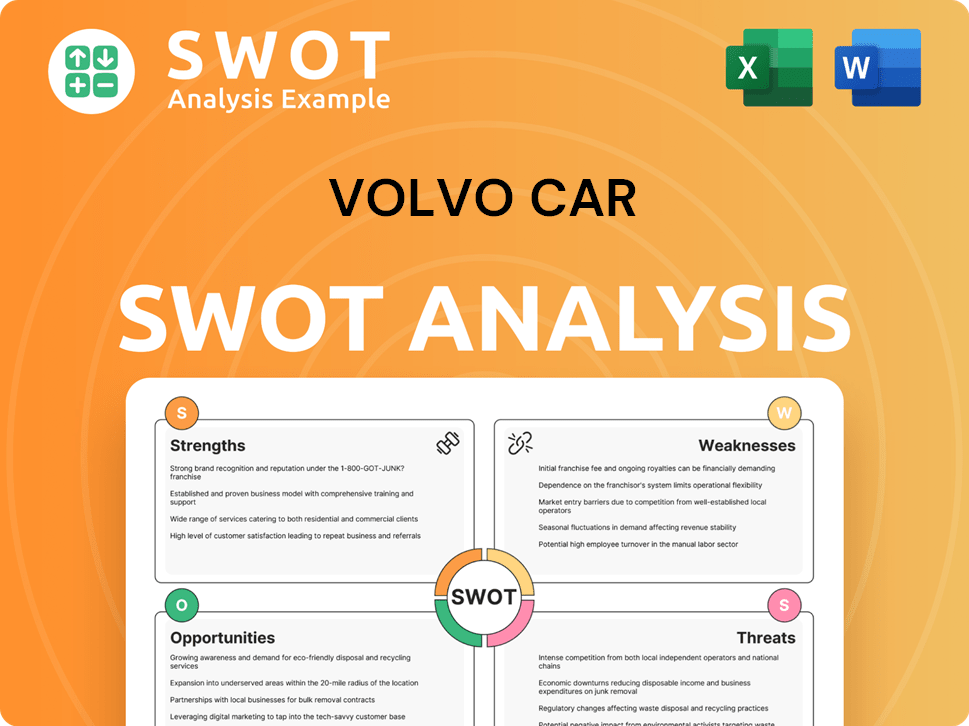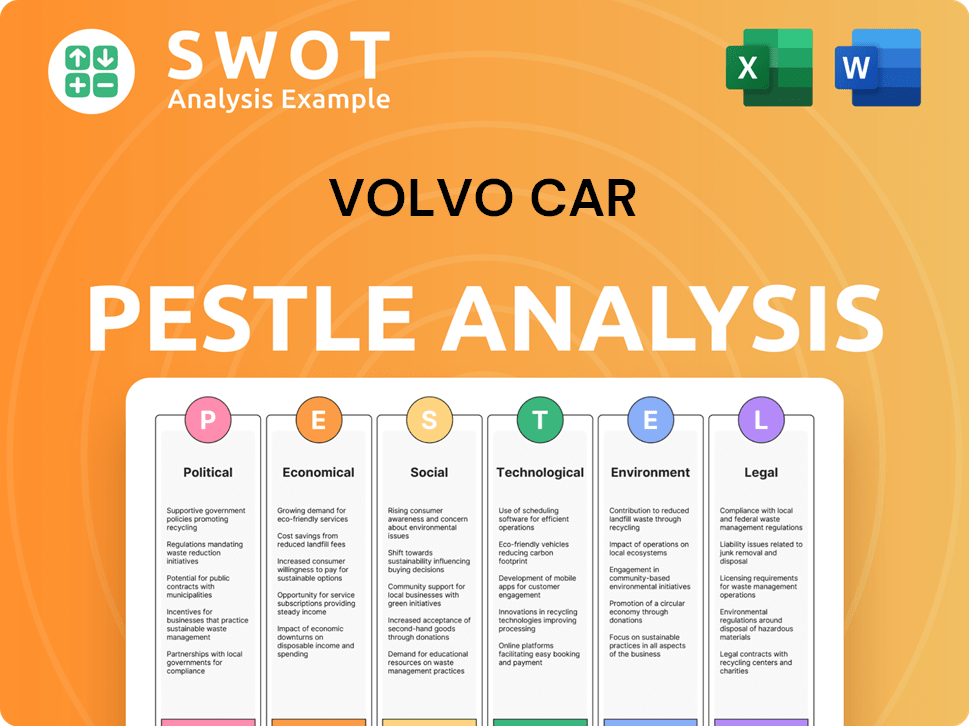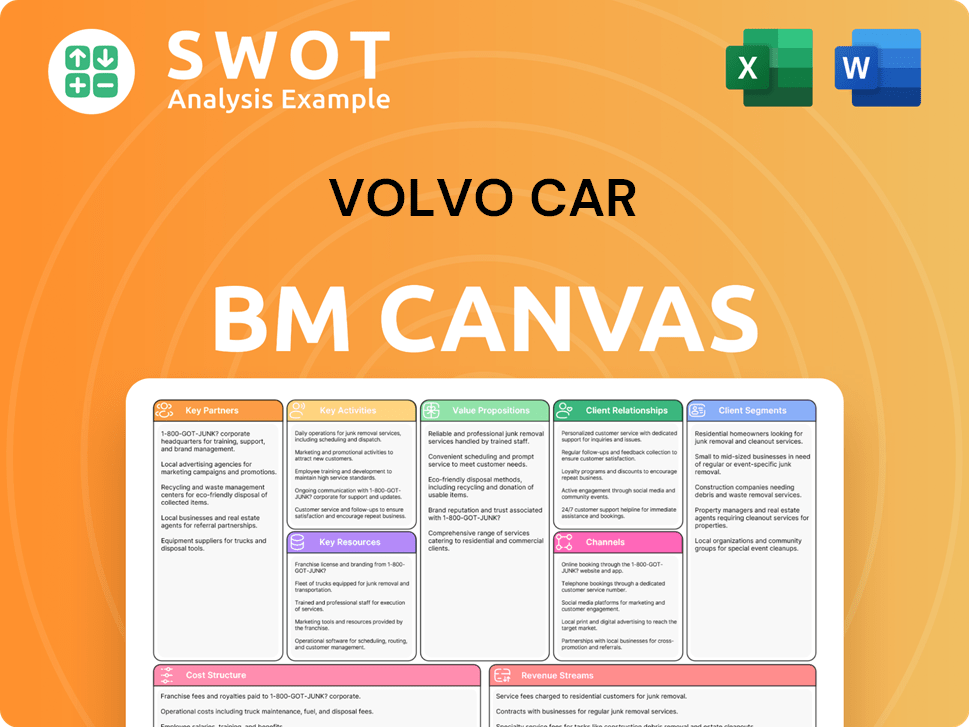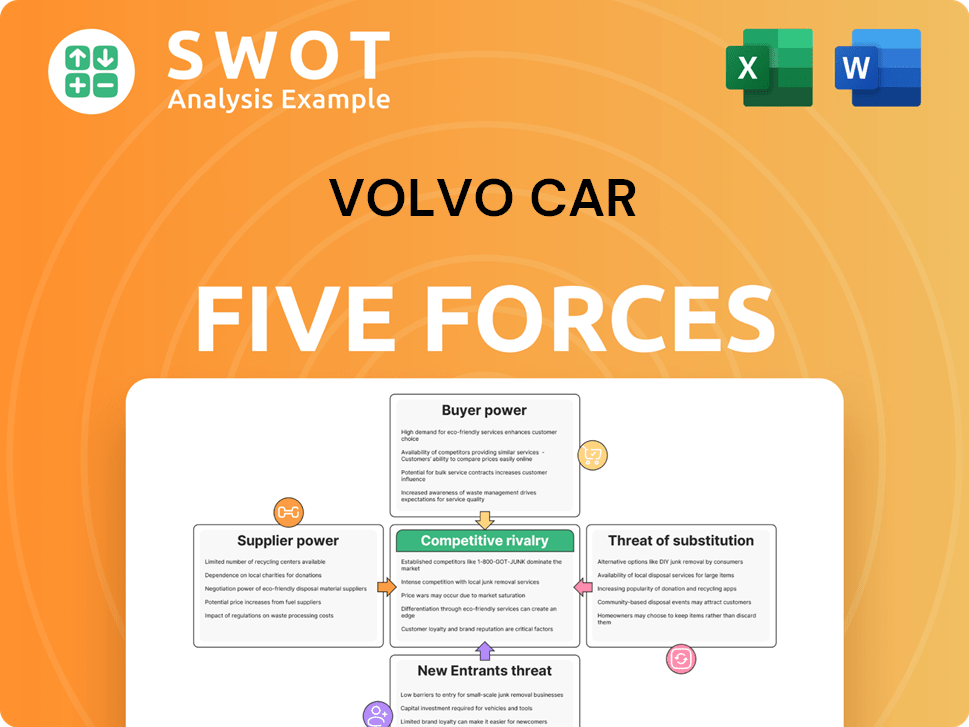Volvo Car Bundle
How is the Volvo Car Company Navigating the Future of Automotive?
Volvo Car Company, a Swedish powerhouse in the luxury vehicle market, is rapidly transforming, especially with its aggressive push into electric vehicles. In 2024, Volvo achieved record sales and revenue, showcasing its resilience and strategic foresight. This success hinges on understanding its operational strategies, particularly its shift towards electric models and commitment to sustainability.

This deep dive will explore the Volvo Car SWOT Analysis, its core operations, and how it generates revenue, providing insights into its strategic moves and competitive advantages. From its rich Volvo history to its innovative Volvo technology, including its Volvo manufacturing processes, we'll examine how Volvo vehicles are designed, tested, and brought to market. Understanding the Volvo car company's global presence and sustainability practices is key to grasping its long-term vision, including how it plans to address common problems with Volvo cars and enhance customer service.
What Are the Key Operations Driving Volvo Car’s Success?
The Volvo car company creates value by designing, manufacturing, and distributing luxury vehicles, including sedans, station wagons, and SUVs. These vehicles cater to customers who prioritize safety, quality, and sustainability. The company also offers related services like financing, insurance, and after-sales support, enhancing its overall customer experience.
Volvo manufacturing operations are extensive, with plants located globally to meet diverse market demands. A key element of the company's value proposition is its long-standing reputation for safety, which continues to influence consumer choices. This focus on safety is a core differentiator in the competitive automotive market.
Volvo vehicles are designed with a strong emphasis on safety features, a legacy that has shaped the brand's identity over decades. The company is also actively integrating circular economy principles, aiming for 30% of its car materials to be recycled by 2030 and new car models to have at least 35% recycled content. This commitment to sustainability is becoming increasingly important to consumers.
Volvo operates manufacturing plants in Gothenburg (Sweden), Ghent (Belgium), Charleston (South Carolina, USA), and several locations in China (Chengdu, Daqing, and Taizhou). These facilities are crucial for producing Volvo models to meet global demand.
Volvo's commitment to sustainability includes aiming for climate-neutral manufacturing. As of January 2024, 69% of company operations are powered by climate-neutral energy. The company plans for all global manufacturing plants to be climate-neutral by 2025. This commitment to sustainability is a key part of its future vision.
Volvo collaborates with partners like Lynk & Co for retail and spare parts distribution in Europe. These partnerships help expand its distribution networks. Collaborations with suppliers for low-emission materials further enhance operational effectiveness.
Volvo's core capabilities include safety innovation and a strategic shift towards electrification and sustainable practices. These capabilities translate into distinct customer benefits and market differentiation. This focus on innovation is central to the company’s strategy.
Volvo's operational processes include manufacturing, sourcing of materials, Volvo technology development, logistics, sales channels, and customer service. The company is focused on addressing emissions and ensuring responsible sourcing of raw materials. For more insights, see the Growth Strategy of Volvo Car.
- Manufacturing plants in multiple countries.
- Emphasis on circular economy and recycled materials.
- Partnerships to enhance distribution and operational efficiency.
- Commitment to climate-neutral manufacturing.
Volvo Car SWOT Analysis
- Complete SWOT Breakdown
- Fully Customizable
- Editable in Excel & Word
- Professional Formatting
- Investor-Ready Format

How Does Volvo Car Make Money?
The Volvo car company generates revenue primarily through the sale of its sedans, station wagons, and SUVs. In 2024, the company's revenue reached a record SEK 400.2 billion (approximately US$36.5 billion), driven by the sale of 763,389 cars. This demonstrates the strong market demand for Volvo vehicles.
A significant portion of revenue comes from electrified vehicles. In 2024, fully electric car sales increased by 54% year-on-year to 175,194 units, accounting for 23% of total global sales volume. Sales of fully electric and plug-in hybrid models combined amounted to 46% of all Volvo cars sold globally in 2024. This indicates a strategic shift towards electric vehicles.
In addition to product sales, Volvo offers services such as financing, insurance, and after-sales support. However, the company has adjusted its monetization strategies. For example, the 'Care by Volvo' subscription service was discontinued in August 2024, focusing instead on traditional sales and leasing models. This strategic pivot reflects a focus on core business operations.
Volvo is implementing several strategies to optimize its financial performance and market position. These include cost-cutting measures and regionalization efforts. The company aims to tailor products and technologies to meet specific market demands, particularly in China and the United States, where it plans to increase local production. For more insights into the competitive landscape, consider exploring the Competitors Landscape of Volvo Car.
- Launched an SEK 18 billion cost and cash action plan in Q1 2025, in collaboration with Geely, to reduce product costs.
- Focusing on regionalization to adapt to different market demands, especially in China and the United States.
- Increasing local production to mitigate the impact of tariffs and enhance market responsiveness.
- Prioritizing traditional sales channels and operational efficiencies.
Volvo Car PESTLE Analysis
- Covers All 6 PESTLE Categories
- No Research Needed – Save Hours of Work
- Built by Experts, Trusted by Consultants
- Instant Download, Ready to Use
- 100% Editable, Fully Customizable

Which Strategic Decisions Have Shaped Volvo Car’s Business Model?
The Volvo car company has a rich Volvo history, marked by significant Volvo manufacturing advancements and strategic shifts. Key milestones include a strong push toward electrification, with Volvo vehicles increasingly incorporating electric powertrains. The company's journey reflects its commitment to innovation and adapting to the evolving automotive landscape.
Strategic moves have been crucial for Volvo, particularly in response to market challenges. These include cost-cutting measures and a global reorganization to streamline operations. The company is focusing on producing more cars where they are sold to counteract the impact of tariffs and trade uncertainties. These actions are part of a broader strategy to ensure long-term sustainability and competitiveness.
Volvo's competitive edge is rooted in its brand reputation, technological advancements, and sustainability efforts. Its dedication to safety, coupled with investments in autonomous driving and electric vehicle technology, sets it apart. Furthermore, its commitment to environmental sustainability reinforces its position in a market that increasingly values eco-friendly practices.
Volvo has seen its electric car sales grow significantly, with fully electric cars accounting for 23% of its global sales volume in 2024. The company initially aimed for 100% electric car sales by 2030 but adjusted this to 90-100% electrified cars (fully electric and plug-in hybrids) by 2030. New product launches, such as the ES90 sedan in Q1 2025, are central to this strategy.
To address global trade uncertainties and rising costs, Volvo initiated an SEK 18 billion (approximately US$1.88 billion) cost and cash action plan in Q1 2025. This plan involves reduced investments and efforts to lower product costs. The company is also reorganizing its global operations into three regions: Americas, Greater China, and Europe & Rest of the World.
Volvo's strong brand reputation, particularly for safety, is a key advantage. The company's technology leadership, including investments in autonomous driving and the 'Superset tech stack' for future electric cars, enhances its competitive position. Its commitment to sustainability, with goals like climate-neutral manufacturing by 2025, further differentiates it in the market.
In May 2025, Volvo Cars announced plans to cut 3,000 white-collar jobs globally, representing about 15% of its office staff, as part of cost-cutting measures. This restructuring is aimed at improving efficiency and cash generation in response to market challenges and economic uncertainties. The company continues to invest in R&D and expand its electric vehicle lineup.
Volvo's vision for the future includes a continued focus on electrification, sustainability, and technological innovation. The company is adapting to new trends and competitive threats by investing in R&D and strategically managing its supply chain. Volvo is committed to maintaining its strong brand image and expanding its global presence.
- Continued expansion of electric vehicle models, including the ES90 sedan and EX30 SUV.
- Strategic partnerships and collaborations to enhance technology and market reach.
- Focus on sustainable manufacturing processes and materials to reduce environmental impact.
- Ongoing investments in autonomous driving technology and safety features.
Volvo Car Business Model Canvas
- Complete 9-Block Business Model Canvas
- Effortlessly Communicate Your Business Strategy
- Investor-Ready BMC Format
- 100% Editable and Customizable
- Clear and Structured Layout

How Is Volvo Car Positioning Itself for Continued Success?
The Volvo car company holds a strong position in the luxury vehicle sector, known for its safety innovations and increasing focus on electric vehicles (EVs) among premium brands. In 2024, the company reported record sales, but faces headwinds in 2025 due to slowing market growth and intensifying competition.
Despite its strong performance in 2024, Volvo anticipates a challenging and turbulent 2025 due to several key risks. These include slowing market growth, intensifying EV competition, and the significant impact of global trade tariffs. The company is responding with cost-cutting measures and a shift towards regionalized operations.
In 2024, Volvo's global sales reached 763,389 cars. Fully electric models accounted for 23% of total sales. Electrified vehicles made up 65% of sales in Europe. The company is a leader in EV market share among legacy premium carmakers.
Slowing market growth and increasing EV competition pose significant challenges. Global trade tariffs, particularly from the U.S., impact imports. Geopolitical tensions and macroeconomic uncertainties are expected to pressure profitability. Volvo's Q1 2025 results showed a decline in revenue and operating income.
Volvo has launched an SEK 18 billion cost and cash action plan. This includes reduced investments and job cuts, such as eliminating 3,000 white-collar jobs. The focus is on a more regionalized operational structure.
Volvo is investing in hybrid models. The company aims to improve cash flow generation and lower costs. They continue to invest in new technologies and sustainability targets, such as achieving climate-neutral manufacturing by 2025.
Volvo is navigating a complex market with slowing EV demand. The company is addressing these challenges through cost-cutting, regionalized operations, and a continued commitment to electrification. The company is also focusing on improving cash flow.
- Slowing EV demand, with a 27% drop in fully electric car sales in May 2025.
- A focus on hybrid models as a bridge to full electrification.
- Emphasis on local production, particularly in the Americas and China.
- Continued investment in new technologies and sustainability.
Volvo Car Porter's Five Forces Analysis
- Covers All 5 Competitive Forces in Detail
- Structured for Consultants, Students, and Founders
- 100% Editable in Microsoft Word & Excel
- Instant Digital Download – Use Immediately
- Compatible with Mac & PC – Fully Unlocked

Related Blogs
- What are Mission Vision & Core Values of Volvo Car Company?
- What is Competitive Landscape of Volvo Car Company?
- What is Growth Strategy and Future Prospects of Volvo Car Company?
- What is Sales and Marketing Strategy of Volvo Car Company?
- What is Brief History of Volvo Car Company?
- Who Owns Volvo Car Company?
- What is Customer Demographics and Target Market of Volvo Car Company?
Disclaimer
All information, articles, and product details provided on this website are for general informational and educational purposes only. We do not claim any ownership over, nor do we intend to infringe upon, any trademarks, copyrights, logos, brand names, or other intellectual property mentioned or depicted on this site. Such intellectual property remains the property of its respective owners, and any references here are made solely for identification or informational purposes, without implying any affiliation, endorsement, or partnership.
We make no representations or warranties, express or implied, regarding the accuracy, completeness, or suitability of any content or products presented. Nothing on this website should be construed as legal, tax, investment, financial, medical, or other professional advice. In addition, no part of this site—including articles or product references—constitutes a solicitation, recommendation, endorsement, advertisement, or offer to buy or sell any securities, franchises, or other financial instruments, particularly in jurisdictions where such activity would be unlawful.
All content is of a general nature and may not address the specific circumstances of any individual or entity. It is not a substitute for professional advice or services. Any actions you take based on the information provided here are strictly at your own risk. You accept full responsibility for any decisions or outcomes arising from your use of this website and agree to release us from any liability in connection with your use of, or reliance upon, the content or products found herein.